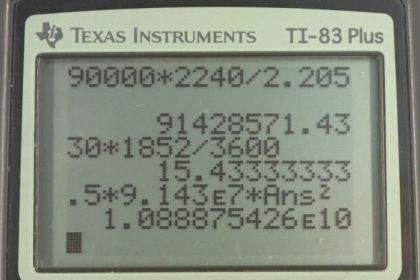This agrees with the textbook data in table 7.1.
Wikipedia article about the Long Ton traditionally used for describing the mass of ships.
Note: @joeyphyics correctly pointed out that table 7.1 specifically says the ship mass is in metric tons, so I should have used that instead of the long ton. On the other hand, long tons are more traditionally used for ships and the conversion is 1 metric ton = 0.984 long tons, so the answer will not change to two significant figures. The answer is good enough, essentially by being lucky, and I like how the solution introduces the concept of the long ton.
Solution video
OpenStax College Physics, Chapter 7, Problem 11 (Problems & Exercises)

Calculator Screenshots
Comments
Table 7.1 in the openstax textbook describes the aircraft carrier as 90000 metric tons instead of tons.
Hi joeyphysics, thank you for spotting this. You're quite right that table 7.1 specifies metric tons, so I should have used that unit. Fortunately the long ton and metric ton are nearly the same, and close enough that the final answer will be the same to two significant figures. I've made a note about this in the final answer section.
Thanks again, and best wishes with your studies,
Shaun


